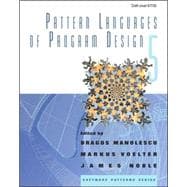
Dragos Manolescu is a software architect with ThoughtWorks, Inc., where he works on architecture evaluation and enterprise integration projects. Involved with the patterns community since 1996, Dragos chaired the PLoP 1999 conference, contributed to Pattern Languages of Program Design 4 (Addison-Wesley, 2000), and coauthored Integration Patterns (Microsoft Press, 2004).
Markus Voelter is a consultant and coach for software technology and engineering. Markus focuses on software architecture, middleware, and model-driven software development. He is the author of several patterns, the coauthor of Server Component Patterns and Remoting Patterns (both Wiley Patterns Series), and a regular speaker at conferences worldwide.
James Noble is professor of computer science and software engineering at Victoria University in Wellington, New Zealand, where he researches object-oriented approaches to user and programmer interface design. He is the coauthor of Small Memory Software: Patterns for Systems with Limited Memory (Addison-Wesley, 2001).
| Acknowledgments | ix | ||||
| Preface | xi | ||||
| Introduction | xvii | ||||
|
1 | (66) | |||
|
3 | (22) | |||
|
|||||
|
|||||
|
|||||
|
25 | (20) | |||
|
|||||
|
45 | (22) | |||
|
|||||
|
67 | (86) | |||
|
69 | (20) | |||
|
|||||
|
|||||
|
|||||
|
89 | (38) | |||
|
|||||
|
|||||
|
|||||
|
127 | (26) | |||
|
|||||
|
153 | (58) | |||
|
155 | (14) | |||
|
|||||
|
169 | (20) | |||
|
|||||
|
|||||
|
189 | (22) | |||
|
|||||
|
|||||
|
|||||
|
211 | (88) | |||
|
213 | (44) | |||
|
|||||
|
|||||
|
257 | (42) | |||
|
|||||
|
|||||
|
299 | (132) | |||
|
301 | (36) | |||
|
|||||
|
337 | (20) | |||
|
|||||
|
|||||
|
|||||
|
|||||
|
357 | (44) | |||
|
|||||
|
401 | (30) | |||
|
|||||
|
431 | (124) | |||
|
433 | (20) | |||
|
|||||
|
453 | (54) | |||
|
|||||
|
|||||
|
507 | (24) | |||
|
|||||
|
531 | (24) | |||
|
|||||
| About the Authors | 555 | (10) | |||
| Index | 565 |
The New copy of this book will include any supplemental materials advertised. Please check the title of the book to determine if it should include any access cards, study guides, lab manuals, CDs, etc.
The Used, Rental and eBook copies of this book are not guaranteed to include any supplemental materials. Typically, only the book itself is included. This is true even if the title states it includes any access cards, study guides, lab manuals, CDs, etc.